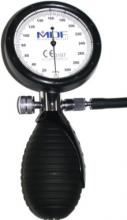The aldosterone antagonists spironolactone and eplerenone are the new darlings of antihypertensive treatment.
This cozy drug category – with just these two agents available in the United States – is the one many experts now recommend for most hypertensive patients with blood pressure that remains elevated after treatment with two or three top-tier agents (diuretic, beta-blocker, or an ACE inhibitor/blocker).
"The best way to treat [resistant hypertension] is with a low dose of a mineralocorticoid antagonist. It has a profound blood pressure lowering effect. This has dramatically changed my outlook on treating hypertension," Dr. Frank Domino said earlier this month at the annual meeting of the American Academy of Family Physicians in Philadelphia. "I hate having patients on three blood pressure medications, with all their adverse effects, and still not controlled. With spironolactone you can often cut back to two meds and still have blood pressure controlled."
Dr. Domino cited a Dutch article last year that reported on 123 patients with "difficult-to-treat" hypertension who had "profound and sustained" blood pressure reductions on spironolactone or eplerenone, while generally well tolerated, with 13 reported adverse events (Int. J. Hypertens. 2011:2011;Article ID 368140 [doi: 10.4061/2011/368140]).
I first reported on the rising star of the aldosterone antagonists for blood pressure reduction almost 4 years ago, when hypertension opinion leader Dr. George Bakris called them his new weapon for treating resistant hypertension in obese patients. Dr. Bakris recently told me that he now views these drugs as the top option for all patients with resistant hypertension, obese or not.
Spironolactone and eplerenone had an interesting path from the outer fringe of hypertension treatment toward the spotlight over the past decade or so. Spironolactone labored in near obscurity for years, following approval in 1960 as Aldactone, a treatment for primary hyperaldosteronism. Landmark findings from the RALES trial in 1999 plucked the drug from the sidelines by showing that adding spironolactone to conventional treatment of patients with advanced heart failure led to substantial improvements in health and survival. Presciently, the authors of that study in 1999 said their results had "implications for the treatment of patients with other conditions in which ACE inhibitors are beneficial, such as patients with hypertension and those who have had a myocardial infarction."
A few years later, eplerenone (Inspra) came on the scene as a somewhat safer (and more expensive) alternative to spironolactone, and was shown in in 2003 in the EPHESUS trial to benefit post–myocardial infarction patients with left ventricular dysfunction, and then last year the EMPHASIS-HF results proved that eplerenone was also beneficial for treating patients with mild heart failure. Today, experts promote the twin aldosterone antagonists as must-use drugs for heart failure patients of all stripes.
Now hypertension is the next frontier for the aldosterone antagonists.
–Mitchel Zoler (on Twitter @mitchelzoler)


